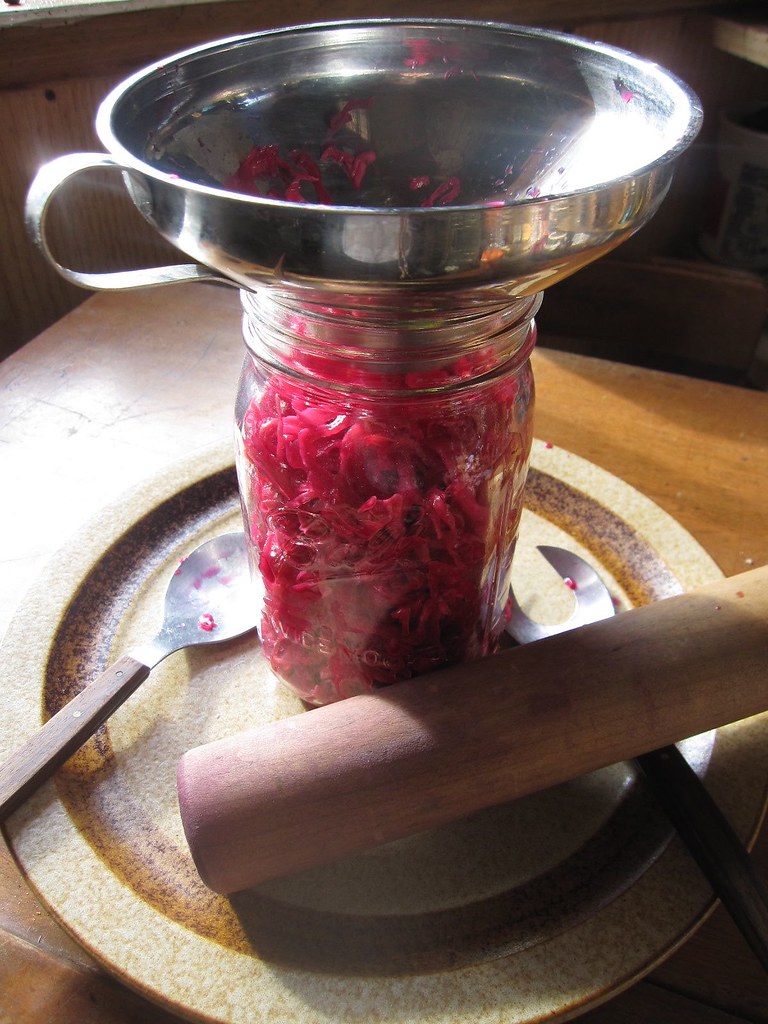
That container gently bubbling in the kitchen, a jar of vegetables and spices and antiseptic salt, is an exercise in patience. It’s a testament of expectation. It’s going to be your sauerkraut in just a few weeks if you can just wait, and taste, and trust.
Ellie Sandor Katz’s seminal work, Wild Fermentation, has been considered the gateway text into a world of natural fermented foods. If you’ve only had jarred pickles or store-bought sauerkraut, you don’t have an inkling as to the delightful smells and flavors that await your experimentation. His book is a mixture of manifesto, recipes, and techniques just waiting for an adventurous microorganism explorer to take advantage of.
At a speaking even at Buffalo Street Books in Ithaca, New York a handful of months ago, Katz entertained a small crowd with tales from the front lines of fermented food aficionados. Some of the crowd were hardened sauerkraut craftsmen, some had just begun their living food journey, and others were just intrigued looky-loos. Katz described the process of home fermentation – typically allowing a crock of vegetables to discover the potential of local micro-fauna from the comfort of an unrefrigerated shelf or counter – as “delightfully subversive.” This crowd, a mixture of older Ithacans with nice wool coats, high schoolers whispering and taking notes in spiralbound binders, and earthy-looking folks in flannel, would not be your typical crowd of subversives. But taking natural fermentation into your kitchen is a way to deliciously ‘stick it to the man’.
What makes home fermentation so seditious is the act of leaving perishable food out on the counter, unrefrigerated, for weeks at a time. In our antiseptic, Clorox-scented modern life, this is a behavior that seems downright crazy. We are far removed from the days of home preservation – very few of us have first-hand experience with the keeping power of salt and whey. That first crock of cabbage, salted and shoved in a jar, will give you shivers and questions – will this keep? Will this work? Am I crazy for trying this?
 Your first bite of aromatic fermented veggie will certainly dispel any of those doubts.
Your first bite of aromatic fermented veggie will certainly dispel any of those doubts.
Wild Fermentation is not your typical cookbook. It’s less of a series of recipes than a discussion of techniques, ideas to jump off of, and an analysis of the separation between modern cookery and traditional foods. If you are a devoteé of following recipes to the letter and rarely stray off the beaten path, there’s plenty for you to try. Katz covers everything from a basic sauerkraut to a complex kim chee, from making your own mead to pineapple vinegar, from dairy ferments like yogurt to bean ferments like miso. However, the intent isn’t for you to stick to the recipes – these are guidelines, meant for you to learn, master, and riff off of.
Are you out of cabbage? Make turnip-kraut!
Bumper crop of butternut? Put up a squash chutney!
Peaches for sale for pennies a pound? Try a fruit vinegar – or maybe a wine!
Normally, books that lean towards the ‘alternative’ crowd and have an ideology – be it raw food, veganism, or locavore – can occasionally become a bit preachy. Katz, who is HIV+ and living a healthy and active life, attests to the healing and restorative power of naturally fermented foods but doesn’t rant or delve into pseudoscience. He finds power in sauerkraut, but wants you to discover it for yourself.
Katz eats naturally fermented food every day, and this recipe book is enough to fill your larder with a huge assortment of tangy and living treats. After receiving this book at Katz’s Ithaca appearance, I quickly put up dilled carrot-kraut and a batch of radish-kraut. As of this moment, they are fermenting happily in my kitchen, forming tiny bubbles and developing their characteristic sour flavor day by day. However, one thing Wild Fermentation doesn’t provide is patience – most of the recipes require at least a few weeks to ferment, and sometimes up to a year! Mine will be watching over my breakfast making for a few more weeks.
But in the mean time, I’m mulling over the multitude of ideas and techniques I’ve learned, happy to know that I’m participating in an activity that was almost given up by the Western World. Good things take time, but that’s about all the effort fermentation takes. Other than that, you just need some veggies, salt, a container, and a little rebellion.

Tempting, very tempting.